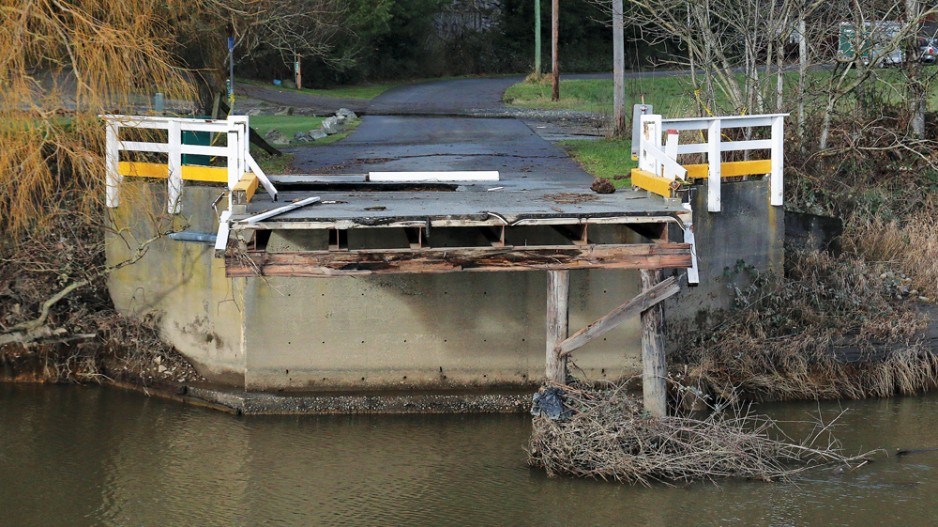Damage to the Coquihalla Highway from flooding in mid-November was so extensive that, a month later, the B.C. government still didn’t have even a ballpark figure for how much it will cost to fix or when it might be fully open.
It’s safe to say, though, that the cost of all the repairs to highways, bridges and dikes damaged by floods will run into the billions. Last week, the federal government announced $5 billion in disaster relief for B.C.
“The level of destruction from the first storm on November 14 was difficult to comprehend for all of us,” said B.C. Transportation Minister Rob Fleming.
The three-day mid-November deluge washed out highways, bridges and rail lines and caused a three-week precautionary shutdown of the Trans Mountain pipeline that resultedin fuel rationing.
While some highways were reopened to commercial trucking and other essential services the Lower Mainland was expected to remain cut off from the rest of B.C. for non-essential travel into the Christmas season. Highway 3 was reopened but restricted to commercial and emergency vehicles only.
While some highways were reopened to essential services, the Lower Mainland was largely cut off from the rest of B.C. for non-essential travel until December 21. The Coquihalla was expected to reopen to commercial trucks and buses on December 20. Highway 3, which had been restricted to essential traffic, was to reopen 24 hours later to non-essential travel.
People who hoped to travel between the Lower Mainland and the Interior and Alberta by car for the Christmas holidays were urged to fly instead.
“I would advise leisure travel to not happen,” Fleming said.
The Coquihalla – a 186-kilometre stretch of Highway 5 from Hope to Kamloops – is a critical link to the Lower Mainland. Some 20 sections of the highway and seven bridges were washed out or otherwise damaged in the mid-November floods.
Despite Highway 3 reopening to non-essential travel, Fleming said it should be avoided if possible during the Christmas season.
He said his ministry had been working with airlines, which would be shifting resources to add flights between the Lower Mainland (Vancouver and Abbotsford) and Kamloops and Kelowna.
Fleming added that, while travel through the U.S. is permitted, sudden restrictions arising from concern about the COVID-19 Omicron variant could potentially strand travellers on the wrong side of the border or force them to pay for COVID-19 tests that are currently waived.
While the government has been focused on immediate repairs to damaged roads and bridges, the next phase of work may involve an expensive hardening exercise aimed at making highways like the Coquihalla more resilient to extreme weather.
“We don’t have a timeline for that yet,” Fleming said. “We have taken some steps very quickly to test the market and see what kind of interest there is in rebuilding a climate-resilient Coquihalla to restore it permanently.”
There are things that can be done to harden roads and bridges against flooding, said Joanna Eyquem, managing director of climate-resilient infrastructure at the University of Waterloo’s Intact Centre on Climate Adaptation.
“One thing we’ve often done in Canada is we’ve sized our bridges and pinch-points at rivers too small.”
Eyquem added that hardening highway and bridge infrastructure could include increasing the width of culverts and bridges.
Some sections of highway, like Highway 8 and Highway 1 through the Fraser Canyon (Lytton-Spences Bridge-Merritt), will have to be moved.
“Stretches of that highway will need to be replaced in a different area than it was originally,” Fleming said. “Embankments and the direction of the river have changed.”
As for railways, Canadian Pacific Railway (TSX:CP) said flooding damaged 30 sections of track in B.C.’s Thompson and Cascade subdivisions, 20 of them experiencing “significant loss of infrastructure.”
CP restored rail service between Kamloops and Vancouver by November 23.
While provinces have jurisdiction over highways, railways are federally regulated, so any plans to make railway infrastructure more resilient to climate change need to be discussed between Ottawa and the railways.
“I can tell you, in my discussions that I’ve had with them, they are acutely aware of the issues and the challenges they face in the [Fraser] Canyon,” said B.C. Public Safety Minister Mike Farnworth. “And I think one of the critical things, as always, is to be able to build back in a way that can withstand climate-related events and other events they may face.” •




